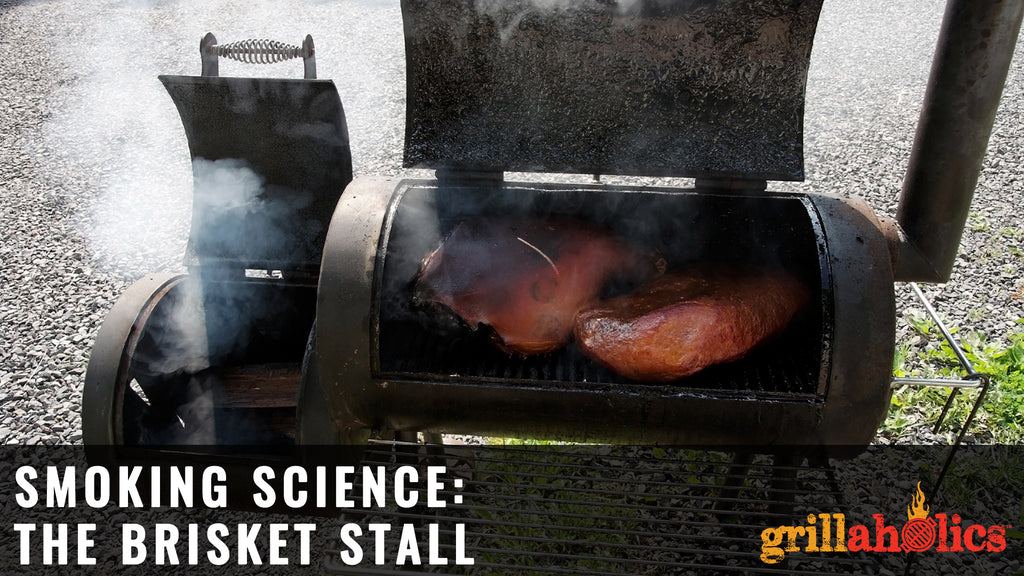The Science of Smoking: The Brisket Stall
Posted by Jake Eller on
Whether you’ve smoked one brisket in your life or a hundred, you know what we mean when we say “The Stall”. You may have learned it the hard way (like some of us here), or maybe you did your research and knew what to expect (good on ya). For the unindoctrinated, the ‘Stall’ (or the Zone, or the Plateau, depending on who taught you) is a temperature dead zone that happens when cooking brisket.
Your brisket will be coming up in temperature, perfectly on track to be done when and how you want it, when apparently without explanation, the cooking just stops. No, your thermometer isn’t broken. Yes, your smoker is still working. What you’ve encountered now is the stall. The culinary equivalent of a sailor’s duldrums. Nothing is happening, and no one knows why. This can last for hours, and can absolutely ruin an otherwise promising cookout if you're not expecting it.
Well, good news -- Grillaholics is here to help you get past the stall.
There’s a lot of noise about the stall. If you ask five different pitmasters about it, there’s a good chance you’ll get five different explanations.
The stall begins at about 150 degrees fahrenheit. That’s also (roughly) the temperature that collagen turns into gelatin within the protein. As such, people have linked these two events together -- somewhat inexplicably, if we’re being honest.
Another idea is that the fat rendering process is to blame for the stall, as that also happens right before 150 degrees. We think that the reason for these two ideas being linked to the stall is the usage of heat energy. The brisket needs heat to make these two things happen, so the meat does not cook as quickly while they do. While this might sound like a reasonable enough explanation, the truth is a little more scientific in nature.
As with most of the culinary mysteries that have been cracked in the past, the true answer was found by a scientifically-minded individual. Dr. Greg Blonder, to be specific. His study conclusively pointed to what is called “evaporative cooling”.
Evaporative cooling is a fairly straightforward process at its core: as you cook the meat, it releases water (sort of like sweating). This water cools down the temperature of the brisket enough that it can essentially halt the cooking process altogether.
For Blonder, his money was on one of two theories when he started: melting fat taking heat energy away from the cook, or evaporative cooling. The experiment he conducted was both simple and conclusive.
Blonder took a chunk of pure beef fat, inserted a temperature probe into it, and put it in his smoker. Alongside that, he took a common cellulose sponge, soaked it in water, and gave it a temperature probe as well. He cooked both of the items together, and recorded the temperature results. These results spoke volumes, and solved the mystery once and for all.
The chunk of fat had no stall, no halt in cooking. Looking at it on a graph, the temperature line took a nice even curve all the way up to 200+ degrees. The water-soaked sponge, however, mirrored a brisket’s cook almost perfectly. At about 140 degrees, it stalled out, and the temperature even went down a couple degrees over the course of the next four hours. After that, when the sponge was properly dried out from the heat, cooking resumed as usual.
In Blonder’s own words:
“Since there was a deep, glistening pool of melted fat in the smoker, the rendering fat hypothesis is busted. The barbecue stall is a simple consequence of evaporative cooling by the meat’s own moisture slowly released over hours from within it’s pores and cells. As the temperature of cold meat rises, the evaporation rate increases until the cooling effect balances the heat input. Then it stalls, until the last drop of available moisture is gone.”
So how do we beat the stall? Blonder’s got us covered there too.
He suggests starting the cooking process a day early. Then, when the brisket hits the stall, remove it from the heat. Wrap the half-cooked protein in foil, then seal it in an airtight plastic bag. From there, dip the plastic bag quickly in ice cold water to halt the cooking process. This way, when you finish cooking it the next day, you will know exactly where you’ve left off. Also, because the smoke flavor is already in the meat by then, feel free to finish in the oven! Though for the purists, (like ourselves), feel free to finish on the smoker.
With a little bit of science, we can ensure there are no nasty surprises during our next cook -- including the dreaded stall! If you’ve got any other tips and tricks for beating the stall, feel free to send ‘em our way or sound off in the comments below!




 RUBS & SEASONINGS
RUBS & SEASONINGS
